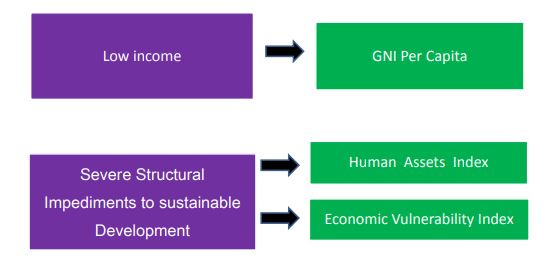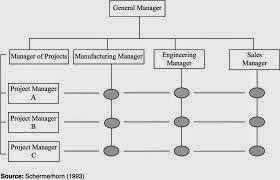Graduation from Least Developed Countries: Indicators, Issues and Strategies of Nepal
The National Planning
Commission has drafted an Approach Paper to graduate from a least developed
country to a developing country by 2022 .This is part of government plan
announced in the 12th periodic plan and reinforced in the 13th plan. The
approach paper to 13th Plan envisages Nepal to graduate to a developing country
by 2022. Nepal is one of the 48 LDCs in the world. For Nepal to graduate to a
developing country it has to meet two of the three criteria the United Nations
has set: gross national income per capita and the threshold for human asset
index which includes health, and nutrition index and Education index. The draft
strategy says that Nepal will have to post an economic growth rate of 9.2%
every year until 2022 to meet the criteria of Human Development Index, Human
Asset Index and Economic Vulnerability Index and invest 17 trillion rupees over
the next nine year.
From
National Human Development Report (2017) : A Least Developed
Country, according to the United Nations (UN), is one that exhibits the lowest indicators
of socio-economic and human development in the ranking of all countries. The
concept of LDCs originated in the late 1960s, with the objective of identifying
the most disadvantaged developing countries in order to provide them with
special assistance. The UN in its resolution 2768 (XXVI) of 18 November 1971
listed the first group of LDCs. LDCs have less developed overall infrastructure
and fewer modern institutions for the efficient delivery of services or
governance, including monitoring and evaluation (M&E), than do other
countries. Their higher educational and/or research organizations, judiciary,
banking systems, business corporations and the like are also less than
adequately developed to match or compete at the international or regional levels.
Furthermore, they have little capacity to engage with modern (international)
market frameworks or adjust to rapid changes that happen in the larger markets
or market-driven socio-economic order without external assistance. Therefore, a
country graduating out of LDC status stands to lose these advantages. However,
when a country graduates out, it is expected to maintain economic growth, have
internal capacities and resources to invest in human capital, negotiate
independently with other countries for trade and financial flows, establish
newer forms of global partnerships, and so on. Also, the development partner
(DP) countries often change their priorities towards those countries which have
attained a certain development status, although there may be other reasons for
their doing so.
From
UN, LDC Portal: The identification of LDCs — defined as
low-income countries suffering from severe structural impediments to
sustainable development — is based on three criteria: (a) per capita gross national
income (GNI), as an indicator of income-generating capacity; (b) the human
assets index (HAI) as an indicator of level of human capital; and (c) the
economic vulnerability index (EVI) as an indicator of structural vulnerability
to exogenous shocks
Fig: LDC Identification
Table: Situation of Nepal
for LDC Graduation on 2015
Source: UN 2015 triennial
review
Situation
1: Gross National Income (GNI) per Capita
Achieving
the GNI per capita threshold seems very challenging for Nepal. Current GNI per
capita is $862 in government report (Economic survey 2016/17). Nepal needs
significant improvement in GNI per capita from $862 to $1242 in 2022 in order meet
the graduation threshold. It is the most challenging indicator for LDC
graduation to Nepal. Therefore, strong macroeconomic policy options are
required to bridge up the gap.
Situation
2: Human Assets Index (HAI)
The
HAI is close to the graduation threshold. Government of Nepal Focused on social
sector with high priority. The adult literacy rate, secondary education
enrolment rate under 5 child mortality rate and child malnutrition rate have
been noticeable improved as a result of intervention and incentives. Nepal
fulfilled HAI criteria which needs to sustain and further improvement in the
future.
Situation
3: Economic Vulnerability Index (EVI)
EVI
is a composite index and it comprises eight indicators like the size of
population, remoteness to international market, merchandise export,
concentration, and share of agriculture, fishers and forestry, share of
population in low elevated, instability of exports of goods and services, victims
of natural disasters and instability of agriculture production. UNDESA reports
shows an EVI value of 26.8 for Nepal which is adequate for graduation threshold,
if any other catastrophic shuck do not impede the economy. However, Nepalese
economy is vulnerable.
From UN, LDC Portal : The Committee reviewed
data on the LDC indices, indicators and additional relevant information to
ascertain which LDCs could be recommended for graduation and which low-income
developing countries could be included in the category. Accordingly, the
Committee found Bhutan, São Tomé and Príncipe and Solomon Islands eligible for
graduation for the second consecutive time and recommended them for graduation
from the list. As decided at the 2015 triennial review, the Committee
considered Kiribati again and found it eligible for graduation for the third
consecutive time. It recommended the country for graduation and further
recommended the creation of a category of countries facing extreme
vulnerability to climate change and other environmental shocks. Kiribati,
Tuvalu and similarly vulnerable countries within that category should receive
support targeting these vulnerabilities. Nepal and Timor-Leste were also found
eligible for the second consecutive time, but were not recommended for
graduation. The Committee will consider Nepal and Timor-Leste again at the next
triennial review, in 2021. At that time, it will also consider Bangladesh, Lao People’s
Democratic Republic and Myanmar which were found eligible for graduation for
the first time at the 2018 triennial review.
The
LDCs at the 2018 triennial review:
Post-LDC Graduation Scenario/
Strategies
·
The post- graduation scenario will also
remain challenging, mostly arising from the implications of the loss of LDC
status and associated benefits such as development assistance and preferential treatments
in international trade.
·
The concessional lending as well as market
entry preferences accorded to Nepali exports in several developed.
·
Nepal needs to strengthen the pre-requestes
required to support a stable and high growth rate and continue the momentum on
the social development front.
o
Full and productive utilization of the
available development assistance and trade preferences to tackle supply-side
constraints, promotion of high value exports and search for niche markets
abroad.
o
Re-orientation of the ongoing structural
transformation to strengthen the industrial sector's and high value production
contribution to GDP, which will help stabilize the growth rate, raise the
income level and create high paying jobs.
·
The available resources and assistance to
tackle the most blinding constraints to economic activities have to be
effectively utilized with an objective to sustain high growth and rapid poverty
reduction.
·
Challenging task is to make the GDP growth
more responsive to industrial sectoral growth and high value agriculture
productive and low value agriculture and service sector activities.
Issues and Challenges to adequately
meet the prerequisites for high growth
·
Structural
bottlenecks
Low
quality HR and deficient skills, weak backward and forward linkages, fragmented
value chain, negligible R and D
investment , distorted labor market characteristic by high minimum wages and
low productivity.
·
Supply-side
constraints
The
Lack of adequate supply of electricity, transport bottlenecks, lack of raw
materials leading to high import content of goods, inadequate supply of key
inputs to boost productivity and political disturbance.
Measures for LDC graduation
·
Improvement in the productive capacity is
the major challenges and requires targeted assistance and strategies.
·
The government, the private sector, NGOs
and others need to coordinate for steering innovation and replacing it.
·
The external resources necessary to play a
pivotal role in expanding its productive capacities, promoting FDI and trade
and adopting technological innovation.
·
Investing in agriculture sector need to be
a priority area for Nepal as it related to food security and poverty reduction.
·
In trade sector, the country has to go for
labor intensive manufacturing exports including expansion to production and
export supply capacity.
·
The support from development partners to
enhance its supply side capacity and trade diversification.
·
A series of targeted Programmes is needed
to address the issue of pervasive poverty.
·
The economy needs increased access to
financial resources in achieving sustained inclusive and equitable growth.
·
Nepal needs further efforts in good
governance, the rule of law, the protection of human rights and democratic
participation.
Conclusion
No
country that has graduated without crossing the income threshold, Nepal attempts
to graduate without meeting the GNI criteria. Achieving GNI per capita is still
a challenging job in Nepal. Need to achieve high, broad based and sustained
growth .Nepal needs further investment and initiate modernization in health and
education sector to strengthen HAI. To improve EVI, macroeconomic stability is
precondition. Similarly external trade balance should be maintained. The government
has been making efforts to develop an enabling environment to accelerate the
pace of the growth and development in partnership with private sector,
corporate sector, non-government sectors and development partners as well.





Comments